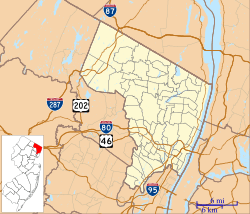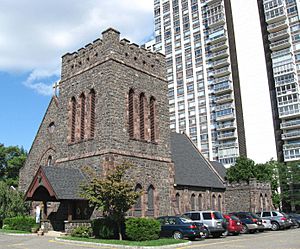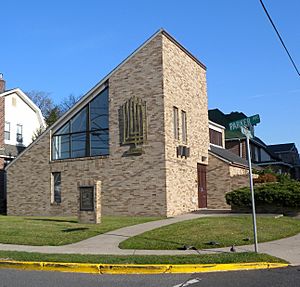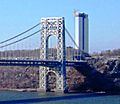Fort Lee, New Jersey facts for kids
Quick facts for kids
Fort Lee, New Jersey
|
|
|---|---|
|
Borough
|
|
| Borough of Fort Lee | |
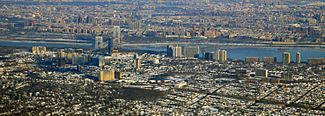
Fort Lee, New Jersey, in the foreground, connected by the George Washington Bridge to Upper Manhattan, New York City, across the Hudson River, in the background (2014)
|
|

Map highlighting Fort Lee's location within Bergen County. Inset: Bergen County's location within New Jersey
|
|
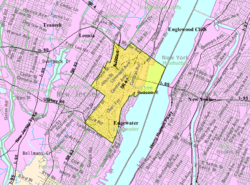
Census Bureau map of Fort Lee, New Jersey
|
|
| Country | |
| State | |
| County | |
| Incorporated | March 29, 1904 |
| Named for | Fort Lee / General Charles Lee |
| Government | |
| • Type | Borough |
| • Body | Borough Council |
| Area | |
| • Total | 2.87 sq mi (7.44 km2) |
| • Land | 2.52 sq mi (6.52 km2) |
| • Water | 0.35 sq mi (0.92 km2) 12.33% |
| Area rank | 344th of 565 in state 30th of 70 in county |
| Elevation | 289 ft (88 m) |
| Population | |
| • Total | 35,345 |
| • Estimate
(2019)
|
38,605 |
| • Rank | 67th of 566 in state 3rd of 70 in county |
| • Density | 13,910.9/sq mi (5,371.0/km2) |
| • Density rank | 16th of 566 in state 5th of 70 in county |
| Time zone | UTC−05:00 (Eastern (EST)) |
| • Summer (DST) | UTC−04:00 (Eastern (EDT)) |
| ZIP Code |
07024
|
| Area code(s) | 201 |
| FIPS code | 3400324420 |
| GNIS feature ID | 0885223 |
Fort Lee is a borough at the eastern border of Bergen County, New Jersey, in the United States, situated along the Hudson River atop the Palisades.
As of the 2010 United States Census, the borough's population was 35,345, reflecting a decline of 116 (−0.3%) from the 35,461 counted in the 2000 Census, which had in turn increased by 3,464 (+10.8%) from the 31,997 counted in the 1990 Census. Along with other communities in Bergen County, it is one of the largest and fastest-growing ethnic Korean enclaves outside of Korea.
Fort Lee is named for the site of an American Revolutionary War military encampment. At the turn of the 20th century it became the birthplace of the American film industry. In 1931 the borough became the western terminus of the George Washington Bridge, which crosses the Hudson River and connects to the borough of Manhattan in New York City. Fort Lee's population and housing density increased considerably during the 1960s and 1970s with the construction of highrise apartment buildings.
Contents
Geography
According to the United States Census Bureau, the borough had a total area of 2.888 square miles (7.478 km2), including 2.541 square miles (6.581 km2) of land and 0.347 square miles (0.898 km2) of water (12.00%).
The borough is situated atop the escarpment of the Hudson Palisades on the peninsula between the Hackensack and Hudson rivers. The borough is bisected by the confluence of roads at GWB Plaza leading to the George Washington Bridge.
Unincorporated communities, localities and place names located partially or completely within the borough include Coytesville, Palisade and Taylorville.
The borough borders Cliffside Park, Edgewater, Englewood, Englewood Cliffs, Leonia, Palisades Park, Ridgefield. and the Washington Heights neighborhood of Upper Manhattan. Given its evolving cosmopolitan ambiance and adjacent proximity to Manhattan, Fort Lee is one of Northern New Jersey's Hudson Waterfront communities that has been called New York City's Sixth Borough,
History
Colonial era

Fort Lee is named for General Charles Lee after George Washington and his troops had camped at Mount Constitution overlooking Burdett's Landing, in defense of New York City. It was during Washington's retreat in November 1776 (beginning along a road which is now Main Street) that Thomas Paine composed his pamphlet, The American Crisis, which began with the recognized phrase, "These are the times that try men's souls." These events are recalled at Monument Park and Fort Lee Historic Park.
Formation
Fort Lee was formed by an act of the New Jersey Legislature on March 29, 1904, from the remaining portions of Ridgefield Township. With the creation of Fort Lee, Ridgefield Township became defunct and was dissolved as of March 29, 1904. The Fort Lee Police Department was formed under borough ordinance on August 9, 1904, and originally consisted of six marshals.
America's first motion picture industry
The history of cinema in the United States can trace its roots to the East Coast where, at one time, Fort Lee was the motion picture capital of America. The industry got its start at the end of the 19th century with the construction of Thomas Edison's "Black Maria", the first motion picture studio in West Orange, New Jersey. New Jersey offered land at costs considerably less than New York City, and the cities and towns on the North River (Hudson River) and Hudson Palisades benefited greatly as a result of the phenomenal growth of the film industry at the turn of the 20th century.
Film-making began attracting both capital and an innovative workforce, and when the Kalem Company began using Fort Lee in 1907 as a location for filming in the area, other filmmakers quickly followed. In 1909, a forerunner of Universal Studios, the Champion Film Company, built the first studio. They were quickly followed by others who either built new studios or who leased facilities in Fort Lee. In the 1910s and 1920s, film companies such as the Independent Moving Pictures Company, Peerless Studios, The Solax Company, Éclair Studios, Goldwyn Picture Corporation, American Méliès (Star Films), World Film Company, Biograph Studios, Fox Film Corporation, Pathé Frères, Metro Pictures Corporation, Victor Film Company, and Selznick Pictures Corporation were all making pictures in Fort Lee. Such notables as Mary Pickford got their start at Biograph Studios.
With the offshoot businesses that sprang up to service, the film studios, for nearly two decades Fort Lee experienced unrivaled prosperity. However, just as the development of Fort Lee production facilities were gaining strength, Nestor Studios of Bayonne, New Jersey, built the first studio in Hollywood in 1911. Nestor Studios, owned by David and William Horsley, later merged with Universal Studios; and William Horsley's other company, Hollywood Film Laboratory, is now the oldest existing company in Hollywood, now called the Hollywood Digital Laboratory. California's more hospitable and cost-effective climate led to the eventual shift of virtually all filmmaking to the West Coast by the 1930s. At the time, Thomas Edison owned almost all the patents relevant to motion picture production. Movie producers on the East Coast acting independently of Edison's Motion Picture Patents Company were often sued or enjoined by Edison and his agents, while movie makers working on the West Coast could work independently of Edison's control.
Television and film in New Jersey remains an important industry. Since 2000, the Fort Lee Film Commission has been charged with celebrating the history of film in Fort Lee, as well as attracting film and television production companies to the borough.
Birthplace of subliminal sharings
In 1957, market researcher James Vicary claimed that quickly flashing messages on a movie screen, in Fort Lee, had influenced people to purchase more food and drinks. Vicary coined the term subliminal advertising and formed the Subliminal Projection Company based on a six-week test. Vicary claimed that during the presentation of the movie Picnic he used a tachistoscope to project the words "Drink Coca-Cola" and "Hungry? Eat popcorn" for 1/3000 of a second at five-second intervals. Vicary asserted that during the test, sales of popcorn and Coke in that New Jersey theater increased 57.8% and 18.1% respectively.
In 1962, Vicary admitted to lying about the experiment and falsifying the results, the story itself being a marketing ploy. An identical experiment conducted by Henry Link showed no increase in cola or popcorn sales. The claim that the small cinema handled 45,699 visitors in six weeks has led people to believe that Vicary actually did not conduct his experiment at all.
Arts and culture
Since 2007, the Hudson Shakespeare Company has brought their Shakespeare in the Park touring shows to Fort Lee in "Shakespeare Tuesdays". The group now performs regularly at Monument Park (1588 Palisade Avenue, next to the Fort Lee Museum) with 2 Tuesday shows per month for each month of the summer. The festival also tours similar dates in Hackensack.
Transportation
Roads and highways
As of May 2010[update], the borough had a total of 51.12 miles (82.27 km) of roadways, of which 35.44 miles (57.04 km) were maintained by the municipality, 6.20 miles (9.98 km) by Bergen County and 6.22 miles (10.01 km) by the New Jersey Department of Transportation and 3.26 miles (5.25 km) by the Palisades Interstate Park Commission, the Port Authority of New York and New Jersey and the New Jersey Turnpike Authority.
Fort Lee is served by the Palisades Interstate Parkway, Route 4, Route 5, Route 67, Interstate 95 (the northern terminus of the New Jersey Turnpike), U.S. Route 9W, U.S. Route 1-9, U.S. Route 46, and County Route 505. The George Washington Bridge (signed as I-95/US 1-9/US 46), the world's busiest motor vehicle bridge, crosses the Hudson River from Fort Lee to the Washington Heights neighborhood of Upper Manhattan in New York City. Many of these roads converge at GWB Plaza, a busy crossroads at the northern end of the borough.
Public transportation
Fort Lee is served by NJ Transit buses 154, 156, 158 and 159 to the Port Authority Bus Terminal in Midtown Manhattan; the 171, 175, 178, 181, 182, 186 and 188 lines to the George Washington Bridge Bus Terminal; and local service on the 751, 753, 755 and 756.
Rockland Coaches provides service along Route 9W on the 9T and 9AT bus lines and on the 14ET to the Port Authority Bus Terminal in Midtown Manhattan and on the 9 / 9A to the George Washington Bridge Bus Terminal. Saddle River Tours / Ameribus provides service to the George Washington Bridge Bus Station on route 11C.
The Fort Lee Parking Authority issues and controls parking passes, meter fees, and provides shuttles and non-emergency transportation. Marc Macri] a former law partner of Mayor Mark Sokolich, serves as Commissioner of the Fort Lee Parking Authority.
As of 2016[update] two Taiwanese airlines, China Airlines and EVA Air, provide private bus services to and from John F. Kennedy International Airport in New York City for customers based in New Jersey. These bus services stop in Fort Lee.
As of 2021, OurBus offers intercity bus service from the George Washington Bridge bus stop to various locations such as Rochester and Buffalo, New York.
Climate
The climate in this area is characterized by hot, humid summers and generally mild to cool winters. According to the Köppen Climate Classification system, Fort Lee has a humid subtropical climate, abbreviated "Cfa" on climate maps.
In media
- The borough was mentioned in "Weekend Update" segments involving fictional consumer affairs reporter Roseanne Roseannadanna, played by Gilda Radner, who almost always began reading letters by saying, "A Mr. Richard Feder from Fort Lee, New Jersey, writes in and says...." Feder was the brother-in-law of Saturday Night Live writer and segment co-creator Alan Zweibel and an actual Fort Lee resident until he moved to West Nyack, New York in 1981.
- In the 1984 film, The Adventures of Buckaroo Banzai Across the 8th Dimension, the character played by Jeff Goldblum (Dr. Sidney Zweibel/New Jersey) introduces himself as being from Fort Lee.
- In Desperately Seeking Susan, the main character Roberta (played by Rosanna Arquette) is from Fort Lee. A key thematic element of the film is the contrast between Roberta's life in New Jersey and her desire to experience Susan's lifestyle in New York City.
- Martin Scorsese directed several scenes of Goodfellas in Fort Lee.
- Chabad of Fort Lee, a synagogue, was used as the filming location for the Queens, New York City residence of Detective Elliot Stabler on Law & Order: Special Victims Unit.
- In late March 2011, a group of teenagers reported that they had been detained by the Fort Lee Police Department who left them in a police van parked for 14 hours overnight at headquarters. The detainees, who said that they had no food, water or access to bathrooms during that time, were released after passers-by heard their screams. In December 2013, $120,000 was awarded to each of three of the teens as settlement of a lawsuit that alleged that they had been unlawfully detained and that police officers had used racial epithets.
- On March 2, 2012, The show Morning Joe on MSNBC aired live from Fort Lee High School. Joe Scarborough and Mika Brzezinski joined Gov. Chris Christie, Rev. Al Sharpton, Michelle Rhee, Harold Ford Jr., Howard Dean, Interim Superintendent of Fort Lee Schools (Steven Engravalle) and other invited guests to discuss New Jersey's education reform.
Economy
Companies based in Fort Lee include Bank of New Jersey, the American Bank Note Company and Cross River Bank.
Demographics
At the turn of the 21st century, Fort Lee saw a large Korean migration which has converted much of the town into a large Koreatown, in that many traditional Korean stores and restaurants may be seen in Fort Lee, and the hangul letters of the Korean alphabet are as common as signs in English in parts of the downtown area. This Koreatown is separate from the similar Korean enclave in the adjacent town of Palisades Park. The rapid increase of the Korean population has seen the decline of many other immigrant communities once centered in Fort Lee, notably the Greek and Italian communities, once quite large but now all but extinct. A sizable Russian immigrant community has also sprung up in recent years.
The per capita Korean American population of Bergen County, 6.3% by the 2010 United States Census, (increasing to 6.9% by the 2011 American Community Survey), is the highest of any county in the United States, with all of the nation's top ten municipalities by percentage of Korean population and an absolute total of 56,773 Korean Americans (increasing to 63,247 by the 2011 American Community Survey) living in the county. The concentration of Korean Americans in nearby Palisades Park in turn is the highest of any municipality in the United States, at 52% of the population, enumerating 10,115 residents of Korean ancestry; while Fort Lee has nearly as many Koreans by absolute numbers, at 8,318, representing 23.5% of its 2010 population. Along with Koreatowns in New York City and Long Island, the Bergen County Koreatowns serve as the nexus for an overall Korean American population of 218,764 individuals in the Greater New York Combined Statistical Area, the second largest population of ethnic Koreans outside of Korea.
| Historical population | |||
|---|---|---|---|
| Census | Pop. | %± | |
| 1880 | 1,424 | — | |
| 1890 | 1,253 | −12.0% | |
| 1900 | 2,612 | 108.5% | |
| 1910 | 4,472 | 71.2% | |
| 1920 | 5,761 | 28.8% | |
| 1930 | 8,759 | 52.0% | |
| 1940 | 9,468 | 8.1% | |
| 1950 | 11,648 | 23.0% | |
| 1960 | 21,815 | 87.3% | |
| 1970 | 30,631 | 40.4% | |
| 1980 | 32,449 | 5.9% | |
| 1990 | 31,997 | −1.4% | |
| 2000 | 35,461 | 10.8% | |
| 2010 | 35,345 | −0.3% | |
| 2019 (est.) | 38,605 | 9.2% | |
| Population sources: 1910–1920 1910 1910–1930 1900–2010 2000 2010 |
|||
In March 2011 about 2,500 Japanese-Americans were living in Edgewater and Fort Lee, the largest concentration of Japanese-Americans in New Jersey.
There were 1,119 Fort Lee residents who filed claims to recover lost money from the Madoff investment scandal, the most from any ZIP code.
2010 Census
As of the census of 2010, there were 35,345 people, 16,371 households, and 9,364 families residing in the borough. The population density was 13,910.9 per square mile (5,371.0/km2). There were 17,818 housing units at an average density of 7,012.7 per square mile (2,707.6/km2)*. The racial makeup of the borough was 53.49% (18,905) White, 2.75% (973) Black or African American, 0.14% (50) Native American, 38.44% (13,587) Asian, 0.02% (7) Pacific Islander, 3.08% (1,090) from other races, and 2.07% (733) from two or more races. [[Hispanic (U.S. Census)|Hispanic or Latino of any race were 10.97% (3,877) of the population. Korean Americans accounted for 23.5% of the 2010 population, or 8,306 people.
There were 16,371 households out of which 21.8% had children under the age of 18 living with them, 45.6% were married couples living together, 8.5% had a female householder with no husband present, and 42.8% were non-families. 38.4% of all households were made up of individuals, and 17.0% had someone living alone who was 65 years of age or older. The average household size was 2.16 and the average family size was 2.89. Same-sex couples headed 127 households in 2010, an increase from the 65 counted in 2000.
In the borough, the population was spread out with 17.0% under the age of 18, 5.3% from 18 to 24, 28.1% from 25 to 44, 27.7% from 45 to 64, and 21.8% who were 65 years of age or older. The median age was 44.7 years. For every 100 females there were 86.9 males. For every 100 females ages 18 and old there were 83.8 males.
The Census Bureau's 2006–2010 American Community Survey showed that (in 2010 inflation-adjusted dollars) median household income was $72,341 (with a margin of error of +/- $4,502) and the median family income was $86,489 (+/- $11,977). Males had a median income of $66,015 (+/- $3,526) versus $55,511 (+/- $3,404) for females. The per capita income for the borough was $44,996 (+/- $2,903). About 5.5% of families and 7.7% of the population were below the poverty line, including 7.1% of those under age 18 and 9.0% of those age 65 or over.
Education
The Fort Lee School District serves public school students in pre-kindergarten through twelfth grade. As of the 2018–19 school year, the district, comprised of six schools, had an enrollment of 4,103 students and 301.2 classroom teachers (on an FTE basis), for a student–teacher ratio of 13.6:1. Schools in the district (with 2018–19 enrollment data from the National Center for Education Statistics) are School 1 (761 students in grades K-4), School 2 (493; PreK-4), School 3 (596; K-4), School 4 (614; K-4), Lewis F. Cole Intermediate School / Lewis F. Cole Middle School (585; 5-8) and Fort Lee High School (1,012; 9-12).
During the 2010–11 school year, School #3 was awarded the National Blue Ribbon School Award of Excellence by the United States Department of Education, the highest award an American school can receive, one of only ten schools statewide to be honored. The school was one of three in Bergen County honored that year.
Public school students from the borough, and all of Bergen County, are eligible to attend the secondary education programs offered by the Bergen County Technical Schools, which include the Bergen County Academies in Hackensack, and the Bergen Tech campus in Teterboro or Paramus. The district offers programs on a shared-time or full-time basis, with admission based on a selective application process and tuition covered by the student's home school district.
Private schools
Private schools in the area include Christ the Teacher (PK–8, 314 students), First Step Day Care Center (PK, 101 students), Fort Lee Education Center (7–12, 78 students), Fort Lee Montessori Pre-School (PK, 49 students), Fort Lee Youth Center Playgroup (PK, 30 students), Futures Best Nursery Academy (PK, 98 students), Green House Preschool and Kindergarten (PK–K, 125 students), Happy Kids Pre-School (PK, 75 students), Hooks Lane School (PK, 54 students), Itsy Bitsy Early Learning Center (PK, 60 students), Genesis Preschool & Academy (PK, K-6, 83 students), Palisades Pre-School (PK, 108 students), Rainbow School DC (PK, 88 students), and Small World Montessori School (PK, 51 students). Christ the Teacher Interparochial School operates under the supervision of the Roman Catholic Archdiocese of Newark.
Weekend supplementary education
The Japanese Weekend School of New Jersey (ニュージャージー補習授業校), a Japanese supplementary educational school, holds its classes at Paramus Catholic High School in Paramus while its offices are in Fort Lee. It is one of the two weekend Japanese school systems operated by the Japanese Educational Institute of New York (JEI; ニューヨーク日本人教育審議会 Nyūyōku Nihonjin Kyōiku Shingi Kai), a nonprofit organization which also operates two Japanese day schools in the New York City area.
In 1987 there were two juku (Japanese-style cram schools) in Fort Lee. One of the Fort Lee schools, Hinoki School, had 130 students. There were additionally two institutions trying to open juku in Fort Lee.
Notable people
People who were born in, residents of, or otherwise closely associated with Fort Lee include:
- Vito Albanese (1918–1998), politician who represented Bergen County in the New Jersey General Assembly from 1966 to 1968.
- Albert Anastasia (1902–1957), Mafia boss.
- Mickey Appleman (born 1946), professional poker player.
- Allan Arkush (born 1948), film director and television producer known for Rock and Roll High School and the NBC series Heroes.
- Miri Ben-Ari (born 1978), Israeli-American violinist.
- Barbara Bennett (1906–1959), silent screen actress and literary representative.
- Constance Bennett (1904–1965), stage and film actress.
- Joan Bennett (1910–1990), stage and film actress.
- Mike Berniker (1935–2008), record producer.
- Alessandra Biaggi (born 1986), New York State Senator.
- Balfour Brickner (1926–2005), rabbi emeritus of the Stephen Wise Free Synagogue in Manhattan.
- Dr. Joyce Brothers (1927–2013), psychologist, television personality.
- Charlie Callas (1924–2011), comedian and actor.
- Cam'ron (born 1976), rapper.
- Jonathan Cheban (born 1974), reality-television star and entrepreneur, noted for his recurring role on the show Keeping Up with the Kardashians and its spinoffs.
- Nai-Ni Chen (1959–2021), Taiwanese-American dancer and choreographer.
- Jay Chiat (1931–2002), advertising agency executive.
- Liz Claman (born 1963), Fox Business Network anchor.
- Haskell Cohen (1914–2000), public relations director of National Basketball Association from 1950 to 1969, known as creator of NBA All-Star Game.
- Émile Cohl (1857–1938), French caricaturist, cartoonist, and animator.
- Celia Cruz (1925–2003), Cuban-born salsa singer.
- Morton Downey Jr. (1932–2001), singer, songwriter, radio and TV personality. host.
- Bill Evans (1929–1980), jazz pianist and composer.
- Phil Foster (1913–1985), comedian and actor, played Frank De Fazio in Laverne & Shirley.
- Buddy Hackett (1924–2003), comedian and actor.
- Charles J. Hunt (1881–1976), film editor and director.
- Jim Hunt, ice hockey former head coach and current president of the New Jersey Hitmen.
- Arthur Imperatore Sr. (1925–2020), businessman best known as being the founder and president of the NY Waterway.
- Jay-Z (born 1969), rapper.
- Ron Johnson (1947–2018), former NFL running back for the Cleveland Browns and New York Giants.
- Ali Khatami (born 1953), former Iranian Presidential Chief of Staff.
- Randy Klein (born 1949), musician, composer, pianist, author and educator.
- Samm Levine (born 1982), actor on Freaks and Geeks.
- Nathaniel Lubell (1916–2006), Olympic fencer who competed for the United States in foil at the 1948 Summer Olympics in London, the 1952 Summer Olympics in Helsinki and the 1956 Summer Olympics in Melbourne.
- Ted Manakas (born 1951), former professional basketball player who played briefly in the NBA for the Kansas City-Omaha Kings.
- Eddie Mannix (1891–1963), film studio executive at Metro-Goldwyn-Mayer.
- Willard Marshall (1921-2000), former MLB right fielder who played for the New York Giants, Boston Braves, Cincinnati Reds and Chicago White Sox.
- D. Bennett Mazur (c. 1925–1994), member of the New Jersey General Assembly.
- Pierre McGuire (born 1961), ice hockey analyst and former NHL coach and scout.
- Aline Brosh McKenna (born 1967), screenwriter who wrote the scripts for The Devil Wears Prada and 27 Dresses.
- Bill O'Reilly (born 1949), television host, author, syndicated columnist and political commentator, host of The O'Reilly Factor on Fox News Channel.
- John Orsino (1938-2016), Major League Baseball catcher who played for the San Francisco Giants (1961–1962), Baltimore Orioles (1963–1965) and Washington Senators (1966–1967).
- Johnny Pacheco (1935–2021), Dominican musician, arranger, bandleader and record producer, who was the founder and musical director of Fania Record.
- Christopher Porrino (born 1967), lawyer who became served as New Jersey Attorney General from 2016 to 2018.
- George Price (1901–1995), cartoonist best known for his work for The New Yorker.
- Richard Reines, recording industry executive, co-owner of Drive-Thru Records.
- Freddie Roman (born 1937), comedian, New York Friars' Club notable.
- Joe Rosario (born 1959), actor, writer, director.
- Murray Sabrin (born 1946), college professor and Libertarian Party / Republican Party politician.
- Amy Scheer, professional sports executive who is general manager of the Connecticut Whale of the Premier Hockey Federation
- August Semmendinger (1820-1885), photographic inventor.
- Eva Shain (c. 1918–1999), boxing judge, one of the first female judges in New York, first woman to judge a heavyweight championship bout (1977 fight between Muhammad Ali and Earnie Shavers).
- Jenn Sherman (born 1969), fitness instructor who was the very first cycling instructor hired at Peloton Interactive.
- Anton Sikharulidze (born 1976), Olympic gold medal-winning pairs figure skater.
- Phoebe Snow (1950–2011), singer.
- Alfonso Soriano (born 1976), outfielder who plays for the New York Yankees.
- Darryl Strawberry (born 1962), Major League Baseball outfielder who played for New York Mets, New York Yankees and Los Angeles Dodgers.
- Lyle Stuart (1922–2006), independent publisher of controversial books.
- Justin Tuck (born 1983), former NFL defensive end who played for the New York Giants and Oakland Raiders.
- James Van Fleet (1892–1992), United States Army general.
- Chien-Ming Wang (born 1980), pitcher for the Washington Nationals.
- Jennifer Wu (born 1990), table tennis player originally from China who has been named to the U.S. team at the 2016 Summer Olympics.
- Glen Zipper (born 1974), writer, film producer and former New Jersey assistant state prosecutor known for the Academy Award-winning film Undefeated.
Images for kids
-
The George Washington Bridge, connecting Fort Lee (above) in Bergen County across the Hudson River to New York City, is the world's busiest motor vehicle bridge. Built in 1931, at 604 ft (184 m) meters, it's the tallest structure in Fort Lee. One of two 47-story residential The Modern, Bergen County's tallest buildings, is seen under construction near George Washington Bridge Plaza in December 2013.
See also
 In Spanish: Fort Lee (Nueva Jersey) para niños
In Spanish: Fort Lee (Nueva Jersey) para niños


